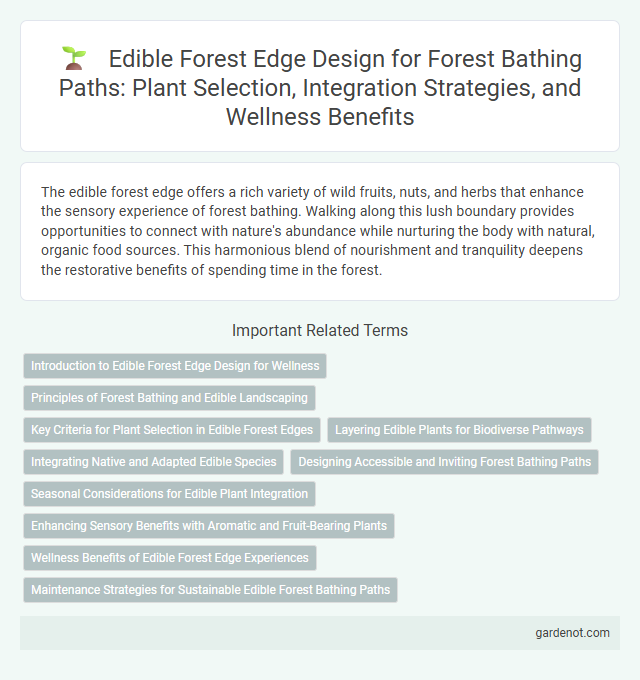The edible forest edge offers a rich variety of wild fruits, nuts, and herbs that enhance the sensory experience of forest bathing. Walking along this lush boundary provides opportunities to connect with nature's abundance while nurturing the body with natural, organic food sources. This harmonious blend of nourishment and tranquility deepens the restorative benefits of spending time in the forest.
Introduction to Edible Forest Edge Design for Wellness
Edible forest edge design integrates diverse, nutrient-rich plants that thrive at the intersection of forest and open space, creating a sustainable source of food and medicine. This approach enhances wellness by promoting biodiversity, offering sensory stimulation, and encouraging mindful foraging experiences along forest bathing paths. Incorporating native fruit trees, medicinal herbs, and berry shrubs supports ecosystem health while fostering a direct connection to nourishing, natural environments.
Principles of Forest Bathing and Edible Landscaping
Edible forest edges combine the principles of forest bathing with edible landscaping to create immersive, sensory-rich environments that promote wellbeing and sustainability. Incorporating native fruit-bearing shrubs, herbs, and nut trees enhances biodiversity while providing natural, nutritious food sources seamlessly integrated into the forest ecosystem. This approach supports mental restoration through nature immersion and encourages mindful foraging that respects ecological balance.
Key Criteria for Plant Selection in Edible Forest Edges
Selecting plants for edible forest edges requires prioritizing species that thrive in partial sunlight and demonstrate resilience to local climate conditions. Key criteria include choosing native fruit-bearing shrubs, nitrogen-fixing plants, and ground covers that enhance soil fertility and promote biodiversity. Incorporating diverse layers of plants ensures sustainable yield, supports pollinators, and maintains ecosystem balance along the forest edge.
Layering Edible Plants for Biodiverse Pathways
Layering edible plants along a forest bathing path creates a rich, biodiverse habitat that supports pollinators and wildlife while offering foragers an abundant variety of fresh, seasonal food. Combining ground covers like wild strawberries with mid-layer shrubs such as elderberries and canopy trees like hazelnuts maximizes space and enhances ecosystem resilience. This intentional planting strategy promotes soil health, carbon sequestration, and a harmonious balance between edible yields and natural forest processes.
Integrating Native and Adapted Edible Species
Integrating native and adapted edible species along the forest edge enhances biodiversity and supports sustainable foraging opportunities. Native plants like wild berries, elderberry, and pawpaw provide essential nutrients and habitat for wildlife, while adapted species such as serviceberry and hazelnut expand the range of edible options suited to local climate conditions. This balanced approach fosters a resilient ecosystem that encourages forest health and enriches the foraging experience on forest bathing paths.
Designing Accessible and Inviting Forest Bathing Paths
Designing accessible and inviting forest bathing paths along the edible forest edge enhances sensory immersion by integrating native fruit-bearing shrubs, nut trees, and medicinal herbs. Clear signage with botanical information and strategic seating areas encourage visitors of all abilities to engage with the diverse flora while promoting seasonal foraging awareness. Incorporating smooth, non-slip surfaces and gentle gradients ensures safe, comfortable access, fostering restorative nature experiences that support mental and physical well-being.
Seasonal Considerations for Edible Plant Integration
Seasonal considerations for edible forest edge integration focus on selecting plants that thrive during specific periods, ensuring continuous availability of fruits, nuts, and greens throughout the year. Early spring plants like wild garlic and ramps provide vital nutrients after winter, while summer yields abundance from berries and herbs such as elderberry and mint. Autumn harvests include hardy nuts and fruits like hazelnuts and hawthorn berries, supporting wildlife and human foragers alike in the edible forest edge environment.
Enhancing Sensory Benefits with Aromatic and Fruit-Bearing Plants
Edible forest edges featuring aromatic herbs like mint, rosemary, and lemon balm enhance sensory experiences through rich fragrances that promote relaxation and mental clarity. Fruit-bearing plants such as elderberry, raspberry, and wild currant provide a natural source of nutrition and encourage mindful foraging along forest bathing paths. The integration of these plants supports biodiversity while enriching the immersive benefits of nature therapy.
Wellness Benefits of Edible Forest Edge Experiences
Edible forest edges offer a unique wellness experience by immersing visitors in nutrient-rich environments where they can foraging fresh, organic fruits, nuts, and herbs that boost immunity and reduce stress. Engaging with these biodiverse ecosystems promotes mindfulness and mental clarity, enhancing emotional well-being through connection with nature's therapeutic properties. Consuming wild edibles along the forest edge also supports digestive health and provides antioxidants that contribute to overall physical vitality.
Maintenance Strategies for Sustainable Edible Forest Bathing Paths
Effective maintenance strategies for sustainable edible forest bathing paths include regular pruning of fruit-bearing shrubs to enhance yield and prevent overgrowth, ensuring nutrient-rich soil through organic composting, and managing invasive species to protect native plants. Implementing seasonal harvesting schedules maintains plant health and maximizes edible output while minimizing ecological disturbance. Incorporating community involvement in path upkeep fosters environmental stewardship and promotes long-term sustainability of the edible forest edge ecosystem.
Edible forest edge Infographic

 gardenot.com
gardenot.com